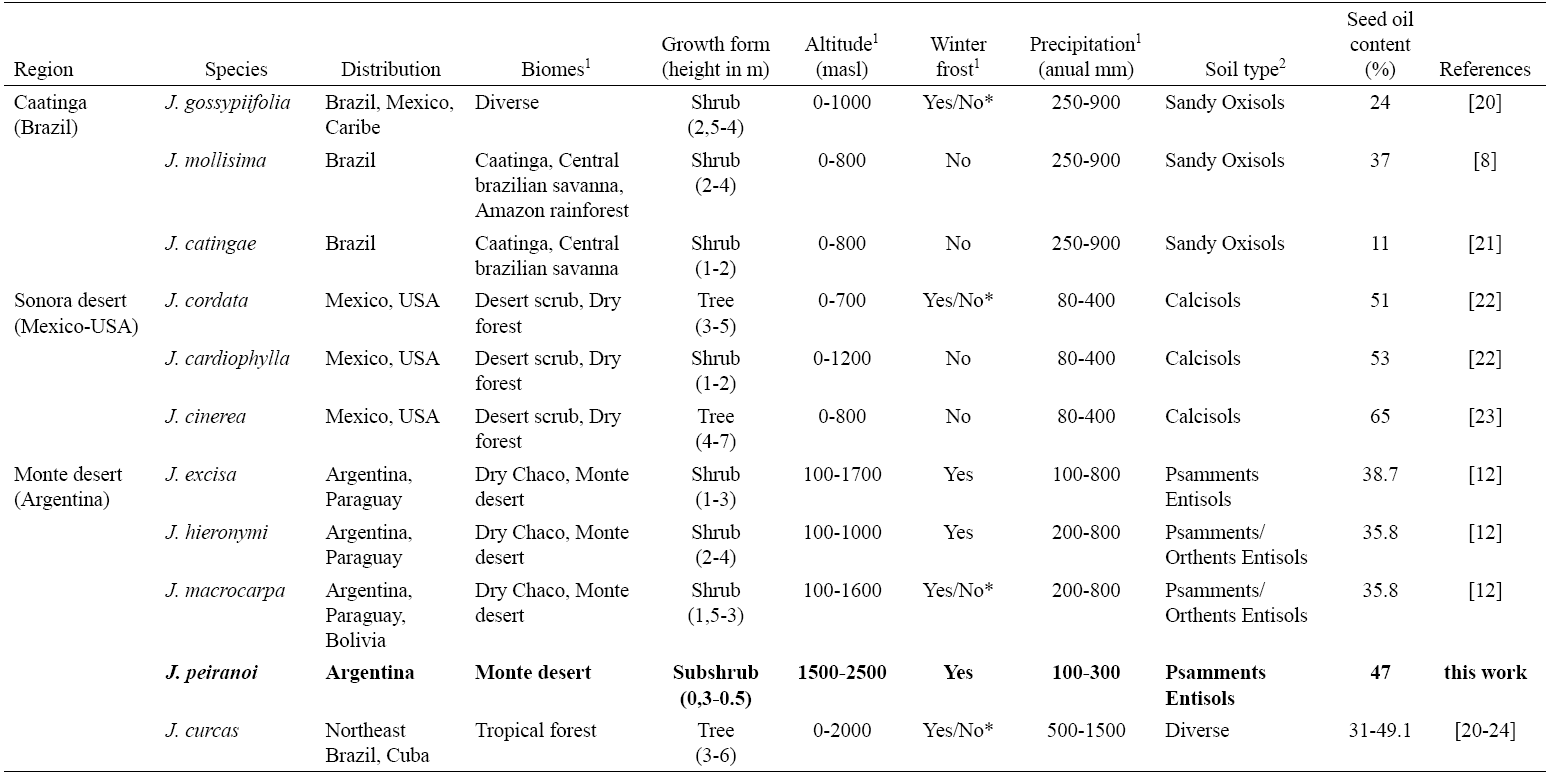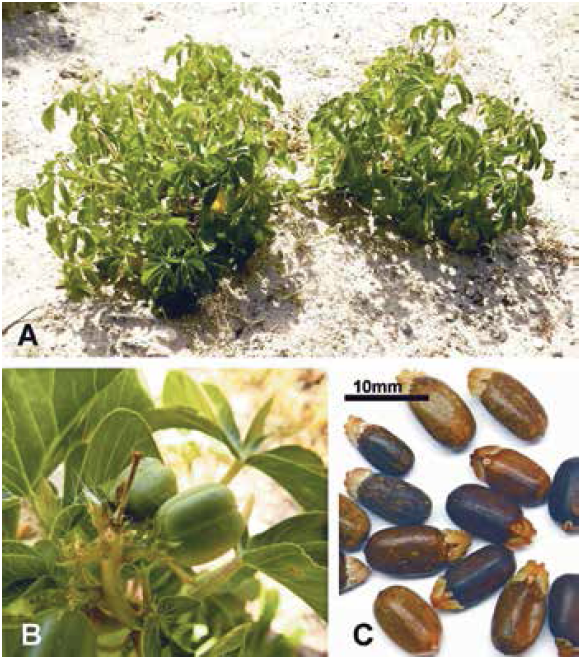Introduction
The genus Jatropha L. (Euphorbiaceae) comprises at least 175 morphologically diverse species distributed in seasonally dry tropical and subtropical regions, with most species (110) being native to Central and South America [1]. In the last decades, some species of this genus, mainly J. curcas L., have gained worldwide attention for their potential economic use as non-edible biofuel-producing crops [2, 3]. Jatropha curcas has also been considered a crop especially suitable for marginal or degraded lands [4], and a significant increase of cultivated areas with this species was noticeable, particularly in tropical and subtropical regions [5,6]. After several years, the disappointing results showed by several large-scale projects, experiments and trials, has brought scepticism about the economic sustainability of J. curcas as a crop, highlighting the limits of its potential production, especially in marginal and less productive environments [7].
For the aforementioned reasons, there is currently an increasing interest in alternative biodiesel crops able to thrive under harsh environmental conditions. In this context, the bioprospecting of new plant species with potential oilseeds native to semiarid and arid ecosystems stands out as a promising field of research. Many species of the Euphorbiaceae family, and especially of genus Jatropha, occur in the semiarid and arid regions of America, including the Atlantic and dry forests of Brazil [8], the Sonora and Chihuahuan deserts [9], and the Dry Chaco and Monte desert of Argentina [10]. Although some research has been done regarding their economic potential as alternative oil resources [e.g., 11, 12, 13], published reports, particularly for those species of semiarid and arid Argentina, are still sparse.
In the present study we contribute to the knowledge of new, non-conventional oilseed species, by exploring for the first time the J. peiranoi Lourteig & O’Donell potential as biofuel plant. The species is endemic to the arid northwest Argentina, where wild populations can be found at elevations as high as 1900 m a.s.l. We report the fruit yield, seed dimensions, biomass, oil content and fatty acid composition from wild plants. Finally, by comparing our results with those from other Jatropha and Euphorbiaceae species, we discuss the potential of the species as feedstock for biodiesel.
Materials and methods
Plant species
Jatropha. peiranoi (subgenus Jatropha) is a 30-50 cm tall monoecious, perennial, deciduous subshrub. It is a geophyte, with a woody succulent, more or less subterranean caudex, a deep root system and decumbent branches that appear annually during the growing season (Fig. 1A). Fruits are trilocular capsules, explosively dehiscent when dry, with a single seed per locule (Fig.1B). The species is endemic to northwest Argentina, with a very narrow distribution restricted to pre-Andean arid valleys between 1700 and 1900 m a. s. l., along a longitudinal stripe of ca. 150 km length and 50 km wide, comprising the provinces of Catamarca, Tucumán and Salta [10]. This area corresponds to the northern Monte desert biome, a shrubby steppe of perennial xerophytes shrubs and cacti, with Larrea cuneifolia Cav. (Zygophyllaceae) as the dominant plant species. Soils are sandy, poor in organic matter and nutrients (entisol order, psamments suborder) and climate is marked seasonally, with average maximum/minimum temperatures of 37/13ºC in summer and 18/3ºC in winter, and annual mean rainfall of 200 mm restricted to the summer wet season [14].
Collection site, fruit production and seed biometrics
Mature fruits and seeds were collected during April 2015 (autumn in the southern Hemisphere) from wild populations located at Santa María valley, Catamarca province of northwest Argentina (27º 00’ S, 66º 14’W, 2200 m a.s.l.). A voucher specimen of the plant was deposited at the Darwinian Herbarium of Buenos Aires. Fruit production was estimated by counting the number of fruits per plant (N = 56 individuals). At least 100 fruits from 50 different individuals were collected, pooled together, and left to discharge inside plastic containers. Fifty healthy seeds were picked up for the biometric determinations, and the viability of other 50 seeds was determined by the tetrazolium test. The weight of each individual seed was determined using a precision balance to the nearest 0.0001g. The water content of the seed was determined after a constant weight was obtained when oven drying the seeds at 70 ºC for up to 24 h, and expressed as percentage on total seed fresh weight basis. Fruit and seed sizes (length x width) were determined with a digital caliper (Tresnaw EC16) with an accuracy of 0.01mm (N = 50). The caruncle (i.e., the lipid-rich fleshy appendage attached to the seed body) was cut off with a blade, and weighed separately.
Lipid extraction and profiling
Seeds (N = 50) were oven dried at 70 °C until constant weight, weighed and ground with a mortar. To determine total seed oil content, 10 g of seed samples were extracted at room temperature using a Soxhlet apparatus with 170 ml hexane for 6 h. The hexane was separated and collected under reduced pressure in a vacuum concentrator. The residue (¼ lipophilic fraction) was dried at 80°C for 12 h and weighed. Fatty acid composition was determined by gas-liquid chromatography according to Aranda-Rickert et al. [12], using a PerkinElmer Clarus 500 gas chromatograph (PerkinElmer Life and Analytical Sciences, Shelton, CT 06484, USA) fitted with a 25-m capillary column (CP-Wax 52 CB; Chrompack, Holland) with a 0.32 mm I.D., 0.25 μm film thickness and equipped with split injection and an FID detector. Individual fatty acids were determined by comparison with retention times of known standards (AOCS-1, Sigma-Aldrich, St. Louis, MO). Total seed oil content is expressed as percentage on a seed dry weight basis. Fatty acids are expressed as the relative percentage of each individual fatty acid relative to the total fatty acids present in the sample. The oil content and fatty acid profile were determined using three different batches of seed samples.
Results and discussion
The mean number of fruits per plant is 8.55 ± 11.3 (± SD, N = 56), with a wide variation among individuals, as many of them produced no fruits. The fruits are oblong in shape and 14.4 ± 0.3 mm length x 9.2 ± 0.2 mm width (mean ± SD, N = 20 fruits). Mature, fresh seeds are 10.1 ± 0.3 mm length x 5.3 ± 0.4 mm width, with a mean total mass of 76.3 ± 8.1 mg (± SD, N = 50 seeds, Fig. 1C). The caruncle represents 3.14 % of the total seed mass (mean ± SD = 2.4 ± 0.4 mg) and biologically, acts as an ant-attractant for secondary seed dispersal [15]. Most seeds were viable (72%, 36 out of 50 seeds). Although the seeds have considerable lower biomass than those of J. curcas (540 ± 90 mg) [11], they are comparable to other wild Jatropha species (e.g. J. excisa: 60.76 ± 11.8 mg) [12], and certainly higher than other Euphorbiaceae reported as potential biofuel species (e.g. Actinostemon concolor: 6.0 ± 0.5 mg; Stillingia trapezoidea: 14.0 ± 0.3 mg; Sapium glandulosum: 52.0 ± 0.5 mg; (means ± S.D.) [16].
The relative oil content was considerable high, with average values of near 47% (Table 1). This oil content is higher than other native Jatropha species reported elsewhere for this region [12], and stands close to the highest values reported for J. curcas as well as for other species from the Sonora desert and central Mexico (Table 2). The seed fatty acid profile of J. peiranoi showed a total of 11 fatty acids, being by far the predominant the linoleic acid (66%), and, albeit to a much lesser extent, the oleic acid (18%), comprising together 84% (Table 1). This relative proportion of oleic and linoleic acids shows remarkable differences with that of J. curcas, in which oleic acid predominates or equals linoleic (34.3-45.8 % and 29.0-44.2% respectively) [16], and is similar to other wild Jatropha species other than J. curcas (J. mollissima, J. gossypiifolia[13], J. excisa, J. macrocarpa and J. hiernoymi[12]). As species desirable for the biofuel industry should have low-density values, and the density is higher when the oil is more highly unsaturated, the high percentages of unsaturated acids as well as linoleic acid in J. peiranoi are major constrains for its use as biofuel [17]. Nevertheless, other species with profiles showing predominantly unsaturated acids have been categorized as drying oils suitable for use in cosmetics, paints, varnishes and lubricants [18].
Table 1 Oil content and fatty acid composition of Jatropha peiranoi seeds. Data are arithmetic means ± SD (N = 3).

Table 2 Distribution, growth form, main habitat features and seed oil content of Jatropha species from three arid regions of America.

1 Including all biomes of the species distribution
2 Variables from the selected arid biome
* species with contradictory information about winter frost in its natural habitat
Northwest Argentina deserts are considered highly vulnerable to climate change, with a predicted increase in temperatures and a decrease in precipitation and soil moisture [19]. In this context, the change of current environmental conditions could make no more viable the commercial production of species such as J. curcas, or even the proposed domestication of J. macrocarpa. The ability of J. peiranoi to survive and produce seeds under a desert climate, its tolerance to water stress, thermal amplitude and winter frost, coupled with an oil seed content greater than 45%, makes it a potential candidate as an oilseed crop for those marginal lands where J. curcas shows unviable. Further studies are necessary to assess the fuel properties of the biodiesel obtained from the seed oil, as well as the improvement of seed yields through the search of high productivity lineages.
Financial support
This work was supported by the Consejo Nacional de Investigaciones Científicas y Técnicas (CONICET) of Argentina. VM has a PhD fellowship from CONICET.











 nueva página del texto (beta)
nueva página del texto (beta)



